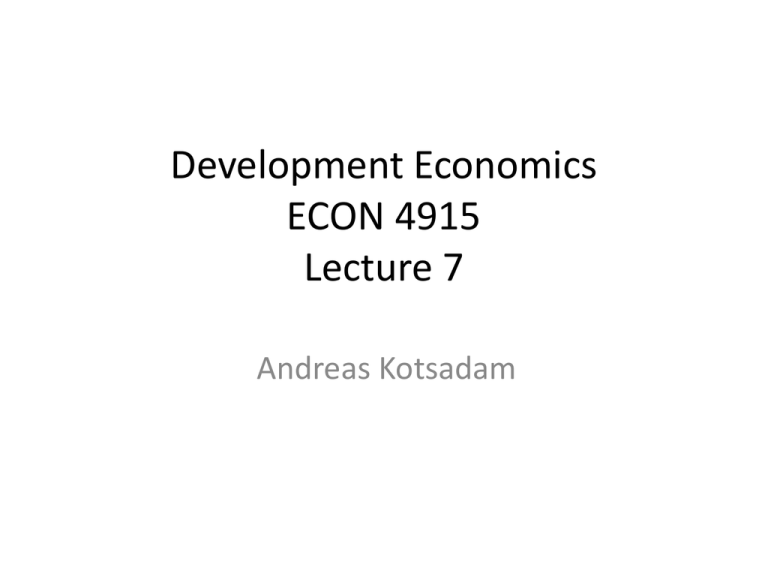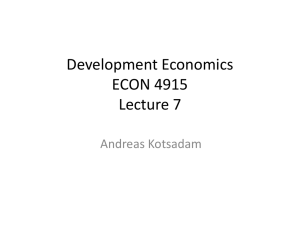Development Economics ECON 4915 Lecture 7
advertisement

Development Economics ECON 4915 Lecture 7 Andreas Kotsadam Outline • Possible exam question and a recap. • Gender and development economics Overview (Duflo 2012) WDR (2012). The economics of gendercide (WDR 2012 and Qian 2008). Possible exam question • The seminar questions for seminar 4. Randomization (5 points). Mechanisms for the resource curse (5 points). The theory of Mehlum et al. (2006) (5 points). Their empirical test (3 points). • Explain the endogeneity problem inherent in the relationship between share of mineral exports and growth. Is the problem solved by using endowments instead? (3 points). Gender and development • An active research area in economics, partly due to the way the world looks like: 6 million women a year go missing. Labor market opportunities. Political representation. Legal rights. Duflo 2012 • How is women’s empowerment related with economic development? • Gender inequality is often greater among the poor, both within and across countries. • Ok, fine, but we also want to know: Does development cause empowerment? Does empowerment cause development? If both are true and/or there are other factors affecting both a virtious cycle could be started. Does development cause empowerment? • Common arguments: Reduces discrimination. Frees up women’s time. Changes expectations. Technological changes (maternal health, washing machines etc.). Discrimination in everyday life • Deaton compares π –ratios for boys and girls: Discrimination under extreme circumstances • Girls are treated differently when ill, e.g. more than twice as likely to die of diarrhea in India. • The excessive mortality rate of girls, relative to boys, spikes during droughts. • When the harvest is bad, due to droughts or floods, and food is scarce, the murder of “witches” is twice as likely to occur as in normal years in rural Tanzania. Policy implications • General interventions to reduce poverty may help women more. • Access to health services (health insurance or free medical care). • Weather insurance and credit. Rose (1999) makes these points clear • In India, the excessive mortality rate of girls, relative to boys, spikes during droughts. • Households that can buffer their consumption in a bad year do not show a dramatic increase in relative mortality of girls during droughts. Summary of general development • Economic development reduces inequality by relaxing the constraints poor households face, thus reducing the frequency at which they are placed in the position to make life or death choices. • By reducing the vulnerability of poor households to risk, economic development, even without specifically targeting women, disproportionately improves their well-being. Expanding women’s opportunities • Parents have lower aspirations for their daughters than for their sons due to women’s fewer opportunities. • Jensen (2012) did an experiment in India where young women’s increased employment increased schooling and weight of girls. But economic growth is not enough • Sex ratios in China worsened despite growth. • Women earn less than men in all countries. • Legal rights are still worse for women and does not seem to follow economic development. • Huge gender gap in political participation and power. Other crucial aspects • • • • • Implicit biases (See lecture 9). Stereotype threats. Attitudes toward risk and competition. Informal care. Rigid power structures. Does empowerment cause development? • Common arguments: Effects of female education. Effects of female decision making in the hh. (Unitary vs. Collective models, see Qian). Productivity effects in agriculture. (Unitary vs. Collective models, see Qian). Effects of female political leaders (See lecture 9) Effects of female education • There is a clear correlation between mother’s education and e.g. child health. • Potential empirical problems? • Some effects are found on fertility but the claim that increasing women’s education, rather than men’s, affects child health is shaky. Things we do not know yet • Effects of legal rules on inheritance, marriage, and divorce. • ”Surprisingly little research”. • Even though there is a lot of variation to be exploited and even though it is likely intimately related to women’s agency. More things we do not know yet • CCT - Should they target women? • Microfinance – if anything the research suggests that targeting women may be bad. • Why? Multiple constraints? Qian 2008 • Research question: The effects of sex-specific earnings on gendercide. Interesting? Yes: Important topic (missing women, especially in China), also important topic in household/labor economics. Original? Yes: previous empirical studies have faced severe identification problems. Feasible? Yes: By exploiting two post-Mao reforms, DD, and IV. A detour on missing women • Women who ”should be alive” but are not. • MW= (Current population*share of females in reference category) – Current number of women. • Globally, 6 million women a year become missing. • 1/5 is never born, 1/10 dies in early childhood, 1/5 in the reproductive years, and 2/5 at older ages. Missing girls at birth After birth Sex ratio of deaths and changes over time The emplirical problem • In linking female share of income with gendercide there is a fundamental identification problem: • Areas with higher female income may have higher income precisely because women’s status is higher for other reasons. • Only looking at tea areas vs non tea areas is not enough either: regions that choose to plant tea may be regions with weaker boy preference. The story • Women have a comparative advantage in producing tea. • Men have a comparative advantage in producing orchard fruits. • Reforms increased the price dramatically. • Areas suitable for tea production receive a shock in female incomes. • More girls survive. Empirical strategy • “… compare sex imbalance for cohorts born before and after the reforms (1st diff), between counties that plant and do not plant sex-specific crops (2nd diff), where the value of those crops increased because of the reform.” = Difference in differences (DD). Recap difference in differences (DD) • Requires that data is available both before and after treatment. • Basic idea: Control for pre-period differences in outcomes between T and C. • Crucial assumption. Absent the treatment, the outcomes would have followed the same trend. • Main practical issue: Omitted variable… you must argue your case strongly! Problems • The main problem is that something else may have happened at the same time. • Or that the trends are different. • More periods is better. Three effects of the reforms are exploited 1) The reform increased the value of adult female labor in tea-producing regions. 2) The reform increased the value of adult male labor in orchard-producing regions. 3) The reform increased total household income in regions with other cash crops which favor neither male nor female labor. Data • Censuses from 1990 and 1997. • Used to get historical fertility and to see which regions plant tea. • ArcGIS data on hilliness. • Increasingly popular to use GIS data in economics. Main equation of interest Basic results Cashcrop Control for varying cohort trends between counties Main worries in DD • The effects may be driven by changes in the control crops. (Testable) • There may have been different pre-trends in sex ratios. (Testable) • Increased price may change the reason people pick tea so that the prereform cohort is not a valid counterfactual. (Use IV) • In, general, we may confound the effects of the reform with effects of other things that happened. (Non-testable) Changes in effects of control crops Stable and close to zero. Pre-and post trends Instrumental variables approach • Tea grows only under particular conditions: on warm and semihumid hilltops. • Use slope of land (i.e. hilliness) as an instrument for tea planting. • Condition 1: Relevance, easily tested. • Condition 2: Validity, not testable. Arguments for validity • Hilliness varies gradually while county boundaries are straight lines. • Estimation with a sample including only adjacent counties gives similar results. • Unless potentially confounding factors change discretely across county boundaries, this increases our belief in the validity. IV Results Education • Planting tea increased female and male educational attainment. • On the other hand, planting orchards decreased female educational attainment and had no effect on male educational attainment. Mechanisms: 4 potential channels • Changed perceptions of daughters’ future earnings. • Girls may be luxury goods. (ruled out by orchard results) • If mothers prefer girls and if it improves mothers’ bargaining power. • Pregnancies are costlier as womens labor is valued more. (ruled out by education results) Interpretation • Introduction: “The results show that an increase in relative adult female income has an immediate and positive effect on the survival rate of girls” (OK). • “… increasing annual adult female income by US$7.70… increased the fraction of surviving girls by one percentage point … (OK??).






